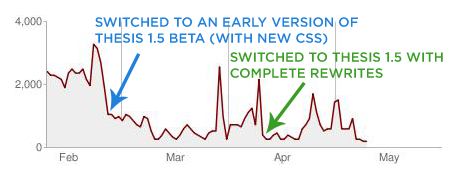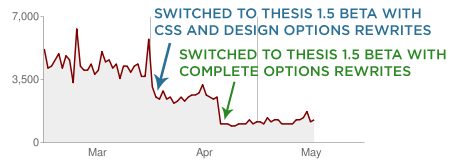This article is deprecated! Any technical information refers to software versions that are now obsolete. Please visit the DIYthemes Blog for current updates, or check out the old Thesis Blog for a treasure trove of website marketing insights.
Although the numerous feature and interface improvements in Thesis 1.5 have received all the attention thus far, the real truth is that the biggest and best advances happened behind the scenes. In an effort to improve efficiency and speed throughout the theme, I completely rewrote the CSS constructor, the data structures for both the Thesis Options and Design Options, and the way options are called upon and used by the theme’s core functions.
While it’s nice to claim that all the work I did resulted in a measurable efficiency improvement, it’s much nicer to check out some graphs that show just how slick Thesis 1.5 really is. Thanks to Thesis rock stars Michael Gray and Bruce Keener, I’ve got some interesting data that reveals the true efficiency gains that Thesis 1.5 brings to the table.
Data? We’ve got that.
Because Thesis is constructed entirely of HTML, CSS, and PHP, its overall efficiency depends on the efficiency of each of these individual elements. As I mentioned earlier, Thesis 1.5 contains an all-new CSS constructor, and in addition, a huge portion of the theme’s PHP has been rewritten as well.
In theory, then, (and assuming I did a good job with the rewrites!) we should see some pretty substantial efficiency gains, and this should translate into faster page load times, reduced server loads, quicker options saves, and less overall bandwidth usage across your Thesis-based site. So, the question becomes—does this theory hold true for Thesis 1.5? Let’s find out!
The following graphs show the average time spent downloading a page (in milliseconds) by the Googlebot while crawling the associated sites. This is an excellent way to measure a site’s code efficiency because the Googlebot only loads HTML, CSS, and PHP (while ignoring images). As you can see, switching to Thesis 1.5 made a dramatic difference in both cases, and now both of these sites are, quite literally, 4 to 5 times more efficient than they were before!

Figure 1. Michael Gray’s average Googlebot crawl times (per page) before and after switching to Thesis 1.5.

Figure 2. Bruce Keener’s average Googlebot crawl times (per page) before and after switching to Thesis 1.5.
Figure 2 is especially interesting because Bruce, who is very technically savvy, was unhappy with the way his site ran on Thesis 1.4.2. In fact, his discontent was the primary reason why I set out to make Thesis 1.5 a model of efficiency. Since Bruce is a trusted friend (and also the very first Thesis customer!), I couldn’t help but deliver on this one, and now the entire theme is better thanks to his feedback.
Nothing like a little tough love from time to time, eh? 😀
UPDATE: Thesis user Marko Saric sent me another awesome graphic that does a fantastic job of highlighting the efficiency improvements in version 1.5. Check it out below:

Figure 3. Marko Saric’s average Googlebot crawl times (per page) before and after switching to Thesis 1.5.
